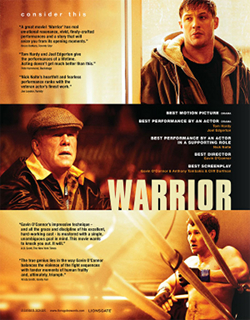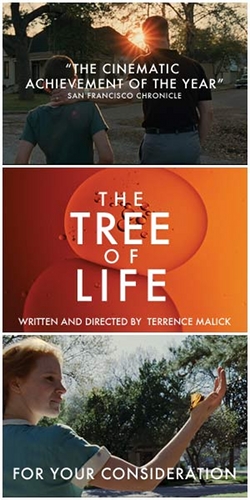Top Ten: Movie Robots
In “celebration” of the release of Real Steel (working title: Rock ‘Em, Sock ‘Em Robots: The Motion Picture), we’re looking this week at the sometimes exciting, sometimes frightening, nearly always cool world of movie robots. Robots have evolved along with the science fiction genre in general, providing images of technology helping or hindering humanity, however the prevailing cultural norms dictate. Whether obviously made of metal or disguised as a person, encompassing androids, gynoids, cyborgs, or automatons (but not mere computers!), the robot takes a crucial place in our collective imaginings about our present and future technological world. Are your favorite robots friends or foes? This Top Ten Tuesday takes a look at the Top Ten Movie Robots.
>> Readers’ Selections
1. WALL-E in WALL-E (2008)
2. T-800 in The Terminator (1984)
3. Gort in The Day the Earth Stood Still (1951)
4. R2-D2 in Star Wars (1977)
5. Roy Batty in Blade Runner (1982)
6. T-1000 in Terminator 2: Judgment Day (1991)
7. RoboCop in RoboCop (1987)
8. David in A.I. Artificial Intelligence (2001)
9. Optimus Prime in Transformers (2007)
10. Teddy in A.I. Artificial Intelligence (2001)
>> Adam’s Selections
1. “Maria” in Metropolis (1927)
The grandmama of all robots, “Maria” (also known as the “Maschinenmensch”) is the mechanical double of sweet-hearted Maria of the future city of Metropolis, a society of exploited underclass factory workers. Her message of peace between the head (society rulers and planners) and the hands (the workers) being the heart is exploited and reversed by the disenchanted inventor Rotwang (Rudolf Klein-Rogge), who sends the false “Maria” to wreak havoc with sex and anarchy. Her unforgettable erotic dancing sends men into frenzy, and even in silent form, her physical incitements to rebel are powerful and overwhelming. Fritz Lang’s and Thea von Harbou’s sci-fi epic presents us with the dangers of demagoguery and exploitation of the working class, yet those masses aren’t left off the hook; among the most haunting images of the entire film is that of “Maria” tied and burned at the stake, “her” true mechanical form showing itself momentarily before being engulfed by the riotous horde’s flames.
2. Roy Batty in Blade Runner (1982)
Although it’s ambiguous how much of Blade Runner‘s replicants include any mechanical or robotic parts, I will err on the side of inclusion for the sake of the Nexus-6, “more human than human,” and no one shows himself to be more Nexus-6 than Roy Batty. A calm, cunning military model replicant, he leads the band of rogue Nexus-6 that “blade runner” Deckard (Harrison Ford) has to track. Batty even resembles that progenitor of the robot concept, Frankenstein’s unnamed monster from Mary Shelley’s novel, an artificial human imbued with reason and intelligence stalking his creator for answers. Much of Blade Runner’s poignancy comes after the frantic final chase between Batty and Deckard, with Batty seemingly triumphant but finally resigned to his lifespan. In some ways a hero, or at least a creation transcending its creator, Roy Batty has truly seen things we people wouldn’t believe.
3. David in A.I. Artificial Intelligence (2001)
A prototype mecha with feelings of attachment and love, David is a robot with the specific capacity to become much more. Actor Haley Joel Osment gives a preternaturally eerie performance, rarely if ever blinking and convincingly playing a boy gradually becoming aware of the nature of his very existence. Alongside David on his journey towards true boyhood are the equally engrossing characters of Gigolo Joe (Jude Law), the worldly male prostitute android, and Teddy, a protective robot teddy bear. The engulfing world of Steven Spielberg’s A.I. fully integrates a host of future robotic possibilities, from terrifying circuses of destruction to the even farther future of advanced mechas with replication technology. David remains maybe the most human of all movie robots, engaging in a search for meaning that all people face at one time or another, contending with disappointment and indulging in the uniquely human pleasures of memory and dreams.
4. T-800 in The Terminator (1984)
Since I go for the high-tech EVE over the low-tech WALL·E below, I’d like to make amends by picking the original model Terminator from James Cameron’s still effective, low-budget film from 1984, rather than the newfangled T-1000 or T-X from subsequent sequels. Arnold Schwarzenegger’s hulking frame doesn’t exactly make for a stealthy cyborg, but the intimidation factor for a remorseless time-traveling assassination robot is high. Utilizing some still neat makeup effects, the T-800 model Terminator even performs makeshift surgery on his metallic insides. The effects would only get better in Terminator 2: Judgment Day (1991), with Schwarzenegger memorably switching sides and indulging in more human-like banter; however, the relentless stalk of his original incarnation, through nightclub and police station to that last stand against Sarah Connor (Linda Hamilton) in the factory, would be the envy of any other hunter-killer robot ever to grace the silver screen.
5. Huey, Dewey, and Louie in Silent Running (1972)
Maybe one of the influential cult sci-fi films ever made, special effects supervisor Douglas Trumbull’s ecologically-minded Silent Running features a trio of unforgettable service bots named after the nephews of Disney’s Donald Duck. Botanist Freeman Lowell (Bruce Dern) tends to some of Earth’s remaining trees and plants in greenhouse domes on the spaceship Valley Forge, but he rebels when ordered to destroy these resources. Once he resists his fellow crew members and commandeers a geodesic dome, Lowell reprograms his robots to perform even more helpful and essential tasks, like performing surgery, planting trees, and playing poker. With boxy, non-anthropomorphic bodies except for mobile feet, the nonetheless poignant, almost human bots are clear antecedents of everyone’s favorite astromech droid, R2-D2 from Star Wars.
6. Gort in The Day the Earth Stood Still (1951)
Inducted into the Robot Hall of Fame in 2006 (look it up!), Gort is the robot all other robots emulate, and probably the one that people first imagine when movie robots are discussed. Tall, metallic, apparently seamless, with an energy beam emerging from his visor-like “eye,” he’s a lethal peacekeeper accompanying Klaatu (Michael Rennie) to Earth to warn of the intergalactic consequences of developing atomic power. Gort is a fascinating machine, extremely intimidating and powerful but tightly controlled with the iconic verbal command “Klaatu barada nikto.” He embodies the natural fear of emotionless, rampant technological innovation from another culture overwhelming ours, yet he remains a mere tool with no will or feeling of his own, the giant “gun” that the Iron Giant (see below) fears he may become. But the story of The Day the Earth Stood Still is Klaatu’s, while Gort remains its most memorable side character, a Cold War image of invincible technology beyond our comprehension.
7. The Iron Giant in The Iron Giant (1999)
If the single word “Superman…” is enough to make you tear up, this is a choice for you. Brad Bird’s Cold War-set parable (adapted from the novel by Ted Hughes and song cycle by Pete Townshend) is about an extraterrestrial robot with destructive weaponry that fights against its own programming by gaining moral awareness. The Iron Giant helps portray the uneasy task of merging technology with ethics, its Cold War milieu embodying the paranoia and fear of “foreignness” that lead to arms races. It’s up to the open, imaginative young Hogarth (Eli Marienthal) to give the Iron Giant a fundamentally decent sense of right and wrong before adults in thrall to nationalism and suspicion can weaponize or blindly destroy what they don’t understand. Giving voice to this dawning ethical sense is the surprising Vin Diesel, processed to seem more robotic but giving an inquisitive, earnest vocal performance nonetheless.
8. Robot Gunslinger in Westworld (1973)
Transforming his iconic role in The Magnificent Seven into a murderous, malfunctioning amusement park bot, Yul Brynner epitomized the silent, implacable killing machine years before Schwarzenegger would take up the mantle. His robot gunslinger is at first a harmless attraction giving patrons the opportunity in indulge in transgressive gunplay in the Old West, but a glitch cascading down the interconnected computers of adult fantasy land Delos begins to provide a taste of how lethal and unrelenting the real West could be. Clad in black and armed with a six-shooter but programmed to be outdrawn by guests, the true terror of melding 19th century iconography with 20th century technology makes itself known as the gunslinger takes bullets, acid, and fire without stopping. He even gets some cool pixilated point of view shots thanks to groundbreaking digital image processing years before a Terminator or Predator would get the same technology-assisted gaze.
In memory of Steve Jobs, I select the sleek, efficient, veritably Apple-designed EVE, Extraterrestrial Vegetation Evaluator, an initially hard-nosed and professional robotic probe scouring Earth to find thriving vegetation and thus a habitable environment. Her anti-gravity flying and itchy plasma cannon immediately distinguish her from the more soulful, peaceable WALL·E, but her all too human frustrations and loneliness leave a place for a robot companion. While WALL·E is surely the film’s heart and soul, EVE gets all the cool gadgets, action sequences, and benefits of advanced technology that the gleaming animation of Pixar can offer. Her not-too-subtle naming points to her and WALL·E (an altogether more plebeian moniker) as unwitting parents to a new phase of humanity. It’s ultimately a benevolent vision of technology adopting humanistic values and even a dollop of nostalgia, a merging of old and obsolete with the shiny and new, WALL·E and EVE, the future immeasurably better by embracing the past.
10. Robot Police in THX-1138 (1971)
The antiseptic, dystopian world of George Lucas’s THX-1138 could only be achieved through an all-pervasive drug regimen and strict regulation of sexual activity, not merely by the inhuman policing of silver black-suited androids. Rather effete and ill-equipped to quell any kind of rebellion, the faceless robot police instead rely on the “we’re only trying to help” deception of the ruling elite, pleading with the rare perpetrator like THX-1138 (Robert Duvall) to reverse his escape just as frequently as they would really beat or shock a transgressive criminal. The populace is kept in a circle of technological slavery by actually producing the robots that keep them in check, THX himself eventually breaking out of his cycle of skilled but drudging work in a robot factory. Visually intimidating but budgetarily constrained and ill-suited for real combat, the robot police are symptoms of a technological dependence that, from the outside, looks easy to escape but, like a lot of technology run amok, thrives on complacency and comfort.
-
http://cinematicmethod.com CinematicMethod
-
http://twitter.com/NextProjection Christopher Misch
-
http://twitter.com/NextProjection Christopher Misch
-
Anonymous
-
http://twitter.com/Ms_Niks Nikki














 Subversive Saturday: Les Contrebandieres (1968)
Subversive Saturday: Les Contrebandieres (1968) Review: Funny Games
Review: Funny Games Review: Cafe Lumiere (2003)
Review: Cafe Lumiere (2003) Review: Back to Stay (2011)
Review: Back to Stay (2011)



